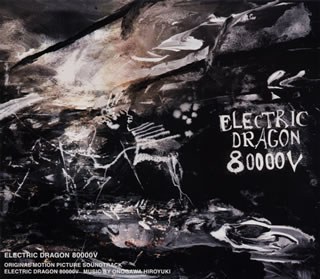Electric Dragon 80.000 V OST
豆瓣
简介
The loudest deafest dumbest noise-score has to be Onogawa Hiroyuki’s freak-out to Sogo Ishii’s Electric Dragon 80,000V (2002). The film details an ongoing battle between two beings literally addicted to electricity, including one who generates megatronic feedback wails through Marshall stacks lining his bedroom wall. For once, a film’s visual pyrotechnics are forcefully welded to its score. The screaming history and histrionics of guitar noise are compressed into slabs which sonically convey the electrified adrenaline surging through these two supermen. Music cues? No – just pure eruptions of energy in place of a recognisable score. Specific to the Japanese context, Electric Dragon 80,000V is a homage to early 60s kid’s TV shows, filmed in black and white and on location in Japan’s outer suburban wastelands – still visually scarred by WWII bombing and the emergent signs of urban renewal. These shows are quaint but amazing – like 40s Italian neo-realism meets 30s Flash Gordon serials – and feature bizarre musique concrete effects to energise the low-budget visual effects. Fondly remembering Japan’s own B-Grade legacy while decimating any sense of warm nostalgia, Onogawa Hiroyuki’s ‘score-core’ perfectly represents the childlike hysteria for superpower and blasts it loudly into the film.
Sogo Ishii’s Gojoe (2000) is his 5th collaboration with composer Hiroyuki Onogawa. In contrast to the biting brute noise of Electric Dragon 80,000V, Gojoe is an epic ‘trans-world’ score for a mystical historical lore – Asian-style. Using his own group Mach 1.67, Onogawa works with a family of traditional Indian singers and tabla players. Sounds like an obvious ethnographic recipe, but Onogawa’s direction of this merger reverberates with the near-deafening majesty of the film’s torrid and sordid battles for power between a Buddhist monk, a grave-robber, a clan head and a vengeful master swordsman. Due to the score’s taiko drum detonations and searing metallic percussive events and tonings, the music casts these figures as gigantic bronze statues of godly proportion. It’s the Asiatic version of Teutonic and Vulcanite powerheads of Western lore, appropriately and evocatively signified through the Indian/Japanese instrumentation and modal improvisation. The orchestration also ably reflects the social and psychological profile of the 4 warring figures (scrapping metal for the grave-robber, court music flute for the lords, etc.). A beautiful stereofield imaging adds to the massive expansiveness of the music, making a CD that seeks to be played loudly.